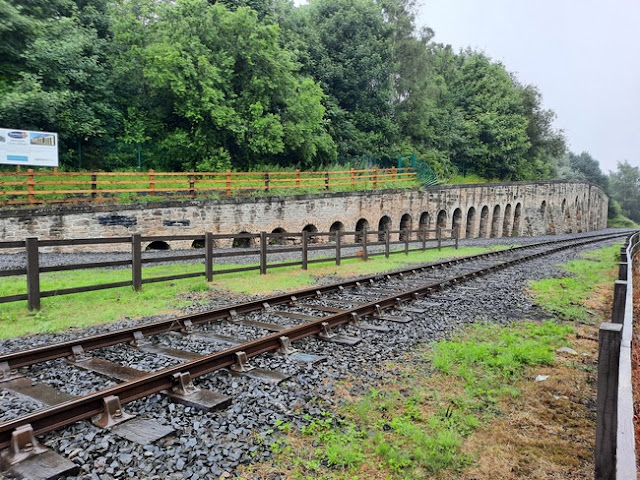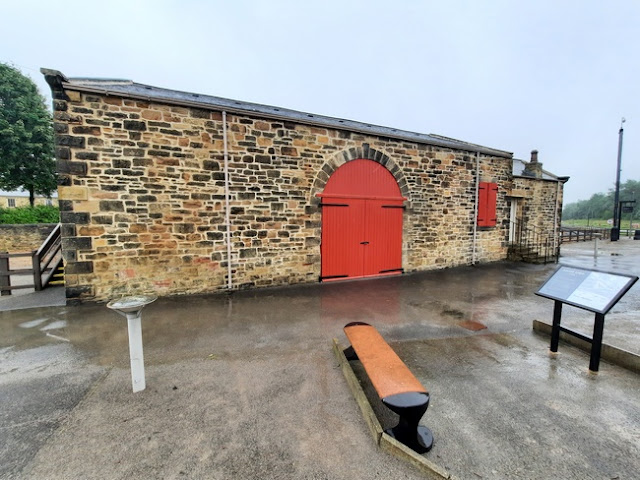A short walk around Shildon. Starting and Finishing Point - Shildon Station
Stockton and Darlington 200 Explores:
Shildon (this page)
Shildon station on the Darlington to Bishop Auckland branch line was in 1825 the western terminus of the Stockton and Darlington Railway, though lines fanned out here to sources of freight in the surrounding area. Shildon was also home to the railway's locomotive superintendent Timothy Hackworth and as a result the line's key engineering facilities were here. The site continued to be an important railway engineering site in to the 1980s as one of British Rail's major wagon works.
Timothy Hackworth's house was turned in to a museum and just over 20 years ago a much more substantial museum was built on the former Shildon Sidings site by the Science Museum Group to act as an out station of the National Railway Museum at York, that museum is named Locomotion after the famous Stockton & Darlington loco. Some of the historic railway related buildings around the site were incorporated in to the museum. The historic buildings are no longer open to look around but have been added to a trail and can be seen from the outside. More information about the historic buildings around the Locomotion site can be found on this part of their website.
Below - The Gaunless Bridge, originally situated on one of the branch lines to the west of Shildon it opened in 1823 and was the first iron truss railway bridge. For years it was displayed outside the National Railway Museum in York but was recently moved to Locomotion at Shildon where it is on display in its original bright colours next to the entrance to the New Hall extension to the Locomotion site.
Below - The former signal box and a couple of line side buildings. The track in the foreground is a demonstration line for the Locomotion museum and the two fenced off tracks are the Darlington to Bishop Auckland line.
Below - The signal box and one of the lineside buildings.
Below - Former coal drops which were in use between 1847 and 1935. The area in which the S&DR operated was covered with coal mines and industries that used the coal so coal traffic was always a key part of the railways in the area.
Below - Information panel at the coal drops.
Below - The ramp up the coal drops.
Below - A couple more line side buildings, these are at the location where the Surtees Railway and Black Boy Branch diverged to serve collieries north of Shildon.
Below - Information board at the line side buildings.
Below - Kilburn's Warehouse, initially an iron merchant's warehouse from 1826 it was later leased by Hackworth, effectively becoming an extension of his Soho works until 1871 when loco building moved to Darlington. It went on to be used by the Shildon Railway Institute for leisure activities for railway workers including sports and band practice.
Below - Information board on Kilburn's Warehouse.
.
Below - Timothy Hackworth's house. Before Locomotion opened the house was displayed as it had been in Hackworth's time. It was a bit controversial that as part of the bigger Locomotion complex much of that disappeared for family friendly displays. The house itself is currently fenced off as discussions are ongoing about how to manage the historic buildings. Behind the house stood the Soho Works, though nothing remains of it the land is used by railway sports clubs.
Below - Information board in front of the house. Note the old photo showing railway lines in front of the house, this was the Surtees Railway the map shows passing in front of the house.
Below - Smaller worker cottages adjoining the house.
Below - The 1888 built Sunday School building. When Locomotion first opened this served as a Welcome Building and on display inside was Hackworth's San Pareil locomotive built for the Rainhill Trials. San Pareil is now moved in to the main building.
Below - San Pareil on display inside back in 2010.
Below - The Goods Yard, looking much as it did on the old maps.
Below - The 1855 built Goods Shed. Previously train rides on the demonstration line started here.
Below - A couple more shots of the Goods Shed.
Below - The replica of San Pareil inside the goods shed shortly after Locomotion opened in 2004.
I did of course visit the Locomotion museum while I was here but as the museum just uses its modern buildings I've not included the pictures of the National Collection items on display in the museum here. The goods lines radiating out from Shildon form footpaths and there are a few surviving historic features, including many buildings from the wagon works to the west of the town. No doubt I will return to Shildon at some point.























.JPG)
.JPG)
.JPG)
.JPG)
.JPG)
.JPG)
.JPG)
.JPG)
.JPG)
.JPG)
.JPG)
.JPG)
.JPG)
.JPG)
.JPG)
.JPG)
.JPG)